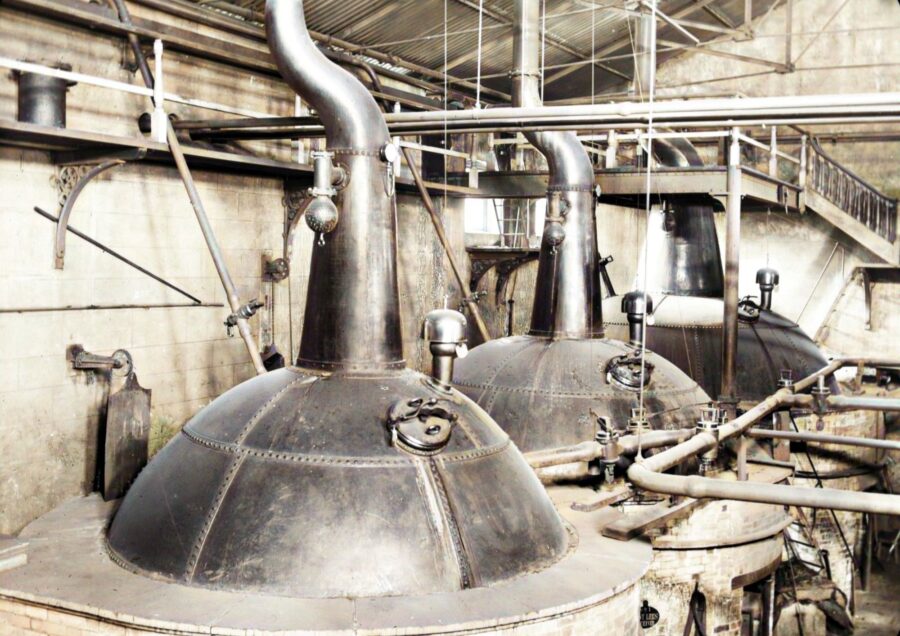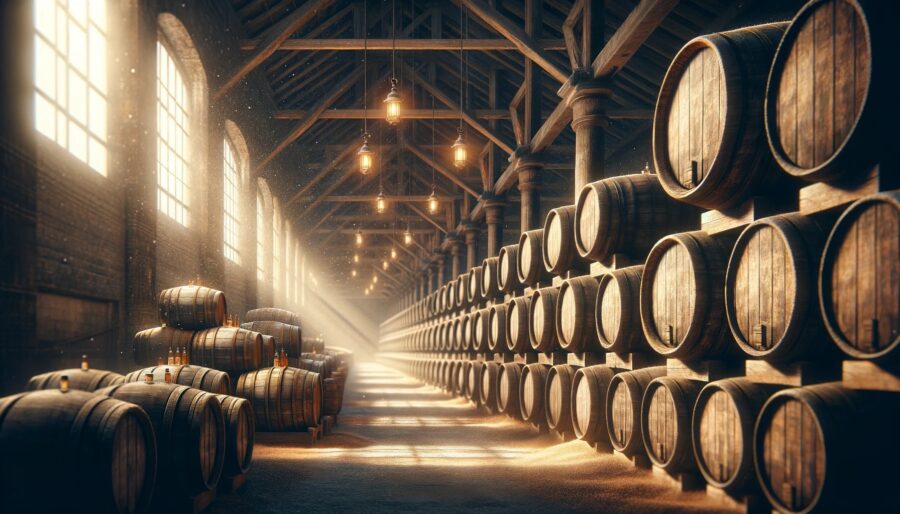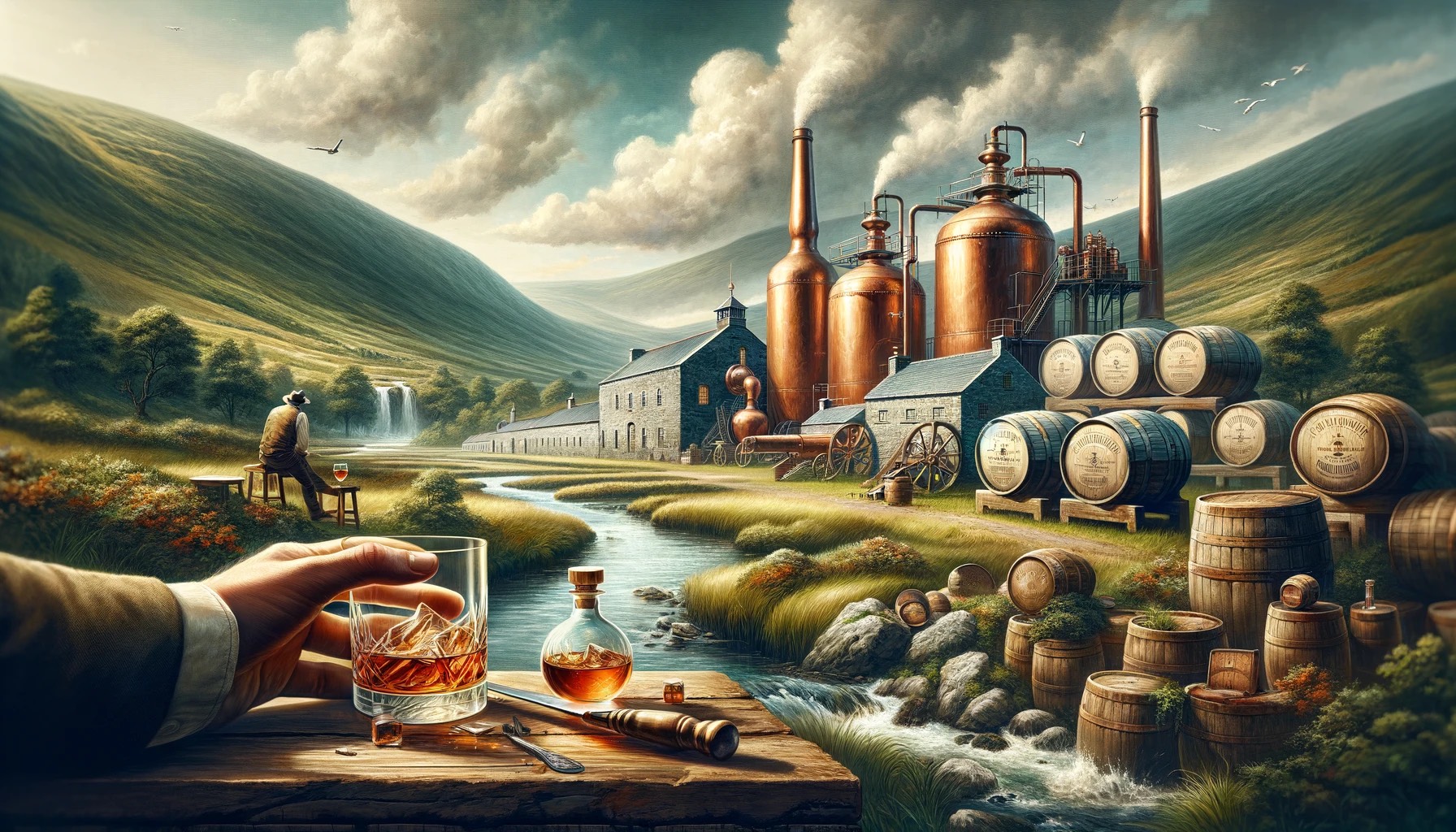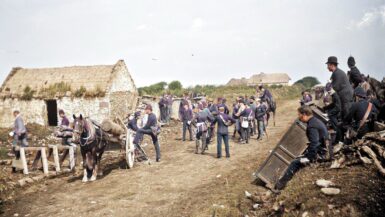Irish whiskey, often hailed as the “water of life,” carries a history as rich and complex as its flavor profile. This storied spirit, deeply embedded in Ireland’s past, is a mosaic of taste, tradition, and cultural importance. It stands out not just for its unique production methods but also for its place in the heart of Irish culture.
Contents
Brief History of Irish Whiskey
The origins of Irish whiskey trace back over a thousand years, making it one of the earliest distilled beverages in Europe. Its roots are often linked to the monastic tradition, with monks believed to have introduced the art of distillation to Ireland. By the 12th century, Irish whiskey was already a well-established tradition, perfected over centuries. The term ‘whiskey’ itself derives from the Gaelic “uisce beatha,” meaning “water of life,” underlining the drink’s importance in Irish society.
Irish whiskey’s golden age spanned the 18th and 19th centuries when Ireland was a global epicenter of whiskey production. This era saw the establishment of the world’s largest distillery in Ireland at the time. However, the 20th century brought challenges, including Prohibition in the United States, trade conflicts with Britain, and the rise of blended Scotch whiskies, leading to a decline in the Irish whiskey industry. It wasn’t until the late 20th century that Irish whiskey began its resurgence, gradually regaining its prominence in the world of spirits.
Distinction of Irish Whiskey from Other Types of Whiskey
Irish whiskey is celebrated for its smoothness and intricate flavor profile, distinguishing it from other global whiskey varieties. This uniqueness is attributed to several aspects of its production:
- Triple Distillation: Many Irish whiskies undergo triple distillation, unlike the typical double distillation of Scotch. This extra distillation step yields a purer, smoother spirit.
- Ingredient Selection: Irish whiskey often incorporates a blend of malted and unmalted barley, contributing to its distinct flavor. This is in contrast to Scotch whisky, which generally uses only malted barley.
- Peat Usage: In contrast to some Scotch whiskies, most Irish whiskies are not dried with peat, resulting in a spirit that is smoother and fruitier, lacking the smoky undertones found in some Scotch varieties.
Irish Whiskey’s Cultural Significance in Ireland
Whiskey in Ireland transcends its role as a mere beverage; it is an integral component of the nation’s cultural tapestry. It symbolizes the famed Irish hospitality and often takes center stage in celebrations and social gatherings. Irish whiskey complements the country’s rich storytelling tradition, often accompanying tales and folklore shared among friends and even strangers.
The revival of Irish whiskey has also significantly impacted Ireland’s economy and tourism. Many distilleries serve as tourist destinations, offering insights into the whiskey-making process through tours and tastings. Festivals and events centered around Irish whiskey underscore its importance, not merely as a product of Ireland, but as an emblem of Irish identity and heritage.
The Early Days: Origins and Evolution
The journey of Irish whiskey is a fascinating tale of innovation, tradition, and survival. From its early days of rudimentary distilling to becoming a globally revered spirit, Irish whiskey’s history is as rich as its flavor.
The Roots of Distilling in Ireland
The distilling tradition in Ireland dates back to around the 6th century, with many historians crediting Irish monks for introducing the technique. These monks, who traveled extensively across Europe, brought back the art of distillation, initially used for medicinal purposes. This knowledge was adapted to distill the first iterations of uisce beatha, the Gaelic term for whiskey, meaning “water of life.”
The early distillation process was primitive, conducted in small-scale operations, often in monasteries. These early stills were basic, typically made from copper, and used to distill a fermented mash of local grains. The resulting spirit was potent and unrefined, far from the smooth whiskeys we know today.
Historical Methods and Ingredients
In its infancy, Irish whiskey was made using ingredients readily available to the distillers. The primary grain was barley, chosen for its abundance and ease of cultivation in the Irish climate. Unlike today’s whiskey, the early versions were likely unaged, as the practice of maturing spirits in wooden casks wasn’t widespread until later.
The distillation process itself has evolved significantly over the centuries. Initially, the operation was small-scale, with the distillate often being pot-distilled. This method involved a simple pot still, where the fermented mash was heated, and the resulting vapors were collected after condensation. These early methods produced a robust, flavorful spirit, setting the foundation for the modern Irish whiskey.
The Evolution of Irish Whiskey Through Centuries
The evolution of Irish whiskey can be divided into several key phases:
- The Middle Ages to the 17th Century: Whiskey production was primarily a local and small-scale affair. Distillers honed their craft, passing down secrets and techniques through generations.
- 18th and 19th Centuries: This era marked the golden age of Irish whiskey. The introduction of more sophisticated distilling methods, such as the patent still, allowed for higher quality and more consistent whiskey. Additionally, the aging process in wooden barrels became standard practice, significantly improving the whiskey’s smoothness and flavor profile.
- 20th Century Challenges: The 20th century was tumultuous for the Irish whiskey industry. Factors like Prohibition in the United States, Irish independence, and subsequent trade wars with Britain, and the rise of Scotch whisky led to a steep decline. Many distilleries closed, and production plummeted.
- Late 20th Century Revival: The late 20th century saw a revival of the Irish whiskey industry. New distilleries emerged, old ones were resurrected, and there was a renewed interest in traditional Irish whiskey styles, like single pot still whiskey. This resurgence was accompanied by innovation in production techniques and marketing strategies, helping Irish whiskey regain its stature on the world stage.

The Distilling Process: A Craft Perfected
The distillation of Irish whiskey is a blend of science, art, and tradition. This process has been refined over centuries, resulting in the smooth and distinct spirit known globally today. Understanding this process provides insight into the craft and care that goes into every bottle of Irish whiskey.
Overview of the Distilling Process
The production of Irish whiskey begins with malting, where barley grains are soaked in water and allowed to germinate. This process releases enzymes necessary for converting the starches in the grain into fermentable sugars. The germinated barley is then dried in a kiln, halting germination. In most Irish whiskeys, this drying process does not involve peat, leading to a smoother, less smoky flavor.
The dried malt is ground into a coarse powder, known as grist, and mixed with hot water in a mash tun. This mixture, or mash, is stirred, allowing the enzymes to further break down the starches into sugars. After mashing, the liquid, now known as wort, is separated and cooled.
Fermentation is the next step, where yeast is added to the wort. The yeast consumes the sugars, producing alcohol and other compounds, resulting in a liquid called wash, with an alcohol content similar to beer.
The wash is then distilled, often multiple times. The distillation process involves heating the wash in a still, where alcohol and other volatile compounds vaporize. These vapors are then condensed back into a liquid form, with the distiller carefully controlling the process to ensure the right balance of flavors.
Differences in Production Methods
- Pot Still Method: Traditional Irish whiskey is often distilled in a pot still, a large copper vessel that allows for a robust and full-bodied flavor. Single pot still whiskey, a signature style of Irish whiskey, is made from a mix of malted and unmalted barley, distilled in a pot still. This method imparts a unique spiciness and richness to the spirit.
- Malt Whiskey: Malt whiskey in Ireland is made solely from malted barley and is generally distilled using pot stills. This style emphasizes the malted barley’s flavor, often resulting in a smoother and sweeter spirit compared to pot still whiskey.
- Grain Whiskey: Unlike malt or pot still whiskey, grain whiskey can be made from a variety of grains, including corn or wheat. It is typically distilled in a column still, which allows for continuous distillation and produces a lighter, cleaner spirit. Grain whiskey is often used in blending to create a balanced profile in blended Irish whiskeys.
Key Elements That Define the Taste and Quality of Irish Whiskey
Several factors contribute to the taste and quality of Irish whiskey:
- Water Quality: The purity and mineral content of the water used in whiskey production are crucial. Ireland’s natural springs and rivers provide soft water, ideal for whiskey making.
- Quality of Barley: The quality of the barley, including where and how it is grown, impacts the flavor. Irish barley is often considered superior due to the country’s optimal growing conditions.
- Distillation Process: The choice between pot stills and column stills, and the number of distillations, significantly affect the final flavor profile. Triple distillation, common in Irish whiskey, produces a smoother and lighter spirit.
- Cask Aging: The aging process in wooden casks is vital for flavor development. The type of wood, previous use of the cask (such as for sherry or bourbon), and the aging duration all contribute to the whiskey’s final taste.
- Blending: For blended whiskeys, the skill of the master blender in combining different whiskeys is crucial. The blender’s expertise ensures a harmonious balance of flavors and aromas, maintaining consistency across batches.
Ingredients: The Heart of Irish Whiskey
The distinctive character of Irish whiskey is largely shaped by its ingredients. Each component, from the grains to the water and yeast, plays a pivotal role in defining the final taste and quality of the whiskey.
Types of Grains Used in Irish Whiskey
The primary grain used in the production of Irish whiskey is barley. Barley is favored for its ability to impart rich, complex flavors and its compatibility with the Irish climate, which is conducive to growing high-quality barley. There are two types of barley used in Irish whiskey production:
- Malted Barley: Malted barley is barley that has been soaked in water to initiate germination and then dried. This process activates enzymes necessary for converting starches in the grain into fermentable sugars. Malted barley contributes significantly to the flavor profile of the whiskey, often imparting a rich, sweet taste.
- Unmalted Barley: Unmalted barley, used alongside malted barley in many traditional Irish whiskeys, particularly single pot still whiskeys, adds a unique spiciness and texture to the spirit. The use of unmalted barley is a distinct characteristic of some styles of Irish whiskey.
Besides barley, other grains such as corn and wheat are also used, particularly in the production of grain whiskey. These grains typically result in a lighter, smoother whiskey and are often used in blends to balance the flavors of malt and pot still whiskeys.
The Importance of Water Quality
Water plays a crucial role in whiskey production, not just in the mashing process but also in the dilution of the spirit before bottling. The quality and characteristics of the water used can significantly influence the final taste of the whiskey. Irish whiskey benefits from Ireland’s natural soft water, which is low in minerals and ideal for whiskey making. This soft water helps in creating a smooth and pure spirit, enhancing the subtle flavors and aromas derived from the grains and aging process.
The Role of Yeast in Fermentation
Yeast is a critical ingredient in the production of whiskey, as it is responsible for the fermentation process. When yeast is added to the cooled wort (the liquid extracted from the mash), it begins to consume the sugars, converting them into alcohol and carbon dioxide. This process not only produces the alcohol content in the whiskey but also generates a range of flavor compounds.
The choice of yeast strain and the conditions under which fermentation occurs can significantly affect the flavor profile of the whiskey. Different strains of yeast can produce varying levels of esters and other compounds, contributing to the fruity, floral, or spicy notes in the whiskey. The fermentation time is also a key factor, with longer fermentation periods typically resulting in a richer, more complex flavor profile.

The Art of Aging: Maturation and Flavor Development
The aging process is where Irish whiskey truly comes into its own, developing its distinct flavors and character. This maturation period is as much an art as it is a science, playing a crucial role in defining the final profile of the whiskey.
The Aging Process and Its Impact on Flavor
Once distilled, Irish whiskey is aged in wooden barrels for a minimum period, during which time it undergoes significant transformations. The aging process serves multiple purposes:
- Flavor Infusion: As the whiskey rests in the barrels, it absorbs flavors from the wood, which can include vanilla, caramel, toffee, and various spice notes. The wood also imparts color to the whiskey, giving it a range from light gold to deep amber.
- Mellowing of the Spirit: The interaction between the whiskey and the wood helps mellow out the harsher elements of the alcohol, making the spirit smoother and more rounded.
- Development of Complexity: Over time, the constant expansion and contraction of the wood, driven by temperature fluctuations, allows the whiskey to breathe. This breathing process enables the whiskey to develop a complex array of flavors and aromas that are not present in the new spirit.
Types of Barrels Used and Their Influence
The choice of barrels for aging Irish whiskey is critical to the development of its flavor profile. The most commonly used barrels include:
- Bourbon Barrels: Many Irish whiskeys are aged in ex-bourbon barrels, which contribute sweet, vanilla, and oak flavors. The use of these barrels is a result of the historical trade between Ireland and the United States.
- Sherry Casks: Some Irish whiskeys are aged or finished in sherry casks, which impart rich, fruity, and nutty flavors. This tradition stems from the historical trade links between Ireland and Spain.
- Other Wine and Spirit Casks: In recent years, there has been experimentation with barrels that previously held other wines and spirits, such as port, rum, or even other types of whiskey. Each type of cask brings its own unique flavors and complexities to the whiskey.
Regulations Around Aging Irish Whiskey
The aging process of Irish whiskey is governed by strict regulations to ensure quality and authenticity. Key regulations include:
- Minimum Aging Period: Irish whiskey must be aged for at least three years in wooden casks. This minimum aging period is essential for the spirit to acquire the characteristics of whiskey.
- Cask Size Limit: The casks used for aging cannot exceed a capacity of 700 liters. This regulation ensures that the whiskey has sufficient contact with the wood to develop its flavors.
- Geographical Restrictions: To be labeled as Irish whiskey, the entire aging process must take place on the island of Ireland. This rule guarantees the geographical authenticity of the spirit.
The art of aging is a vital component in the production of Irish whiskey. The maturation process not only enhances the whiskey’s flavors and smoothness but also reflects the skill and traditions of the distillers. Through careful selection of barrels and adherence to strict aging regulations, Irish whiskey distillers create a spirit that is rich, complex, and deeply rooted in the heritage of Ireland.
Iconic Irish Whiskey Distilleries
Ireland’s landscape is dotted with historic and innovative whiskey distilleries, each with its unique story and contribution to the world of spirits. These distilleries not only create exceptional whiskey but also embody the rich history and tradition of Irish whiskey-making.
Profiles of Major Distilleries in Ireland
- Old Bushmills Distillery: Located in County Antrim, Northern Ireland, Old Bushmills Distillery proudly holds the title of the oldest licensed whiskey distillery in the world, with its license dating back to 1608. Known for its smooth, triple-distilled malt whiskeys, Bushmills is synonymous with quality and tradition.
- Jameson Distillery: Jameson, based in Dublin and Cork, is arguably the most famous Irish whiskey globally. Founded in 1780 by John Jameson, the distillery has played a significant role in popularizing Irish whiskey worldwide. Jameson is renowned for its blended whiskeys, characterized by their smoothness and versatility.
- Midleton Distillery: Situated in County Cork, Midleton Distillery is the powerhouse behind many well-known Irish whiskey brands, including Jameson, Redbreast, and Green Spot. The distillery is celebrated for its innovation and craftsmanship, often leading the way in producing exceptional single pot still whiskeys.
- Teeling Whiskey Distillery: The Teeling Distillery, established in Dublin in 2015, is part of a new wave of Irish whiskey distilleries. Despite its youth, Teeling has gained acclaim for its innovative approach to whiskey-making, including unique cask finishes and experimental mash bills.
- Tullamore D.E.W. Distillery: Tullamore D.E.W., based in the heart of Ireland, is known for its smooth and gentle triple-distilled whiskey. The distillery, with roots going back to 1829, is renowned for its blended whiskeys and innovative maturation techniques.
Historical Significance and Contribution to the Whiskey Industry
Each of these distilleries has contributed significantly to the Irish whiskey industry. Old Bushmills and Jameson have been ambassadors of Irish whiskey for centuries, helping to sustain the tradition through difficult times. Midleton Distillery, with its large-scale operations, has been instrumental in the resurgence of Irish whiskey in the modern era, producing a wide range of acclaimed whiskeys. Teeling represents the new generation of Irish whiskey makers, pushing the boundaries and introducing new techniques and flavors. Tullamore D.E.W.’s focus on triple distillation has set a standard for smoothness in Irish whiskey.
Unique Characteristics of Each Distillery’s Whiskey
Each distillery imparts its unique characteristics to its whiskey:
- Old Bushmills is known for its single malt whiskeys with light, fruity, and spicy flavors, offering a distinct Northern Irish profile.
- Jameson stands out for its exceptionally smooth and versatile blended whiskeys, ideal for both new whiskey drinkers and connoisseurs.
- Midleton produces a diverse range of styles, from the robust and flavorful single pot still whiskeys to elegant and complex single malts.
- Teeling brings innovative flavors to the table, with whiskeys often featuring unconventional cask finishes like rum, port, or wine barrels, adding unique flavor profiles.
- Tullamore D.E.W. focuses on a smooth and accessible style, with a characteristic triple-distilled lightness and a balance of fruity, spicy, and toasty notes.
Each of these distilleries plays a vital role in the tapestry of Irish whiskey. Their individual stories, methods, and styles not only reflect the rich diversity within the Irish whiskey category but also contribute to the global appeal and growing popularity of this beloved spirit.
Tasting Irish Whiskey: A Sensory Journey
Tasting Irish whiskey is an art that engages the senses, offering a rich palette of flavors and aromas. This sensory journey not only enhances one’s appreciation of the whiskey but also provides insight into its complex character.
How to Taste Whiskey Like a Connoisseur
- Glass Selection: Use a tulip-shaped glass or a Glencairn whiskey glass to concentrate the aromas at the top of the glass.
- Observe the Color: Hold the glass up to the light. The color of the whiskey can give clues about its age and the types of casks used during maturation.
- Nose the Whiskey: Swirl the whiskey gently in the glass to release its aromas. Bring the glass to your nose and take a few short sniffs. Try to identify the different notes. Are they fruity, floral, spicy, or woody?
- Sip, Don’t Swallow: Take a small sip and let it roll around your mouth. Notice the mouthfeel – is it light, creamy, or oily? Let the whiskey gently touch all parts of your palate.
- Savor and Identify Flavors: Try to discern the different flavors. Look for the sweetness of fruit or vanilla, the spice of oak or rye, the richness of toffee or chocolate, or the smokiness (if any).
- Finish: After swallowing, pay attention to the aftertaste or ‘finish’. A long finish is often a sign of a high-quality whiskey.
- Adding Water or Ice: Experiment with adding a few drops of water, which can open up new flavors and aromas. Ice can be added, but be aware that it might dull some of the complexities.
Identifying Flavors and Aromas
Irish whiskey typically presents a spectrum of flavors and aromas, including but not limited to:
- Fruity Notes: Look for apple, pear, citrus, or dried fruits.
- Spicy Notes: Detect the presence of spices like cinnamon, nutmeg, or pepper.
- Sweet Notes: Identify vanilla, honey, caramel, or butterscotch.
- Woody Notes: Notice oak, cedar, or hints of tobacco.
- Floral Notes: Sense the subtle aromas of flowers like heather or rose.
- Earthy Notes: Be aware of the peatiness or graininess, more prevalent in some whiskeys.
Pairing Irish Whiskey with Food
Pairing whiskey with food can enhance both the whiskey and the dish:
- Light, Floral Whiskeys: Pair with seafood, light cheese, or salads.
- Rich, Fruity Whiskeys: Complement with pork, chicken, or dishes with creamy sauces.
- Full-Bodied, Spicy Whiskeys: Match with robust foods like steak, game, or strong cheeses.
- Sweet, Smooth Whiskeys: Enjoy with desserts like chocolate, fruit tarts, or ice cream.
Like wine tasting, whiskey tasting is subjective and personal. What matters most is the enjoyment and the experience of discovering the unique characteristics of each Irish whiskey. The process of tasting not only deepens one’s appreciation for the spirit but also connects the drinker to the rich heritage and tradition of Irish whiskey-making.
The Modern Resurgence: Irish Whiskey Today
The Irish whiskey industry is currently experiencing a dynamic and exciting resurgence, marked by rapid growth, innovation, and increasing global recognition. This revival is a testament to the enduring appeal of Irish whiskey and its adaptability in the modern spirits market.
The Recent Boom in the Irish Whiskey Industry
In the last few decades, Irish whiskey has witnessed a remarkable revival, transitioning from a period of decline to becoming the fastest-growing spirits category globally. This resurgence is driven by several factors:
- Diversification of Products: There has been a significant increase in the variety of Irish whiskeys available, from traditional blends to single malts and pot still whiskeys, appealing to a broader range of consumers.
- Rise in Popularity Among Younger Drinkers: Irish whiskey has gained popularity among younger demographics, who are attracted to its approachable flavor profile and the rich heritage associated with it.
- Increased Investment: Significant investments in marketing, distribution, and production capacities have helped elevate the profile of Irish whiskey on the world stage.
New Distilleries and Innovations in Whiskey Making
The booming interest in Irish whiskey has led to a renaissance in distillery openings and innovative whiskey-making practices:
- Proliferation of New Distilleries: The last two decades have seen a dramatic increase in the number of distilleries in Ireland, with many new players entering the market, offering unique and artisanal whiskeys.
- Innovation in Production: Contemporary distilleries are experimenting with various aspects of whiskey production, including new types of grain, innovative distilling techniques, and unique cask finishes (such as wine, rum, or exotic wood barrels) to create distinct flavor profiles.
- Focus on Sustainability: Modern distilleries are increasingly adopting sustainable practices, such as using locally sourced ingredients and implementing environmentally friendly production methods.
Irish Whiskey in the Global Market
Irish whiskey’s ascent in the global market is a remarkable success story:
- Growing Exports: Irish whiskey has seen a substantial increase in exports, with significant growth in markets like the United States, Europe, and Asia. It is now one of the most widely exported spirits from Ireland.
- Increasing Global Recognition: Irish whiskey is gaining acclaim internationally, winning awards and recognition in global spirit competitions, enhancing its reputation for quality and craftsmanship.
- Cultural and Tourism Impact: The popularity of Irish whiskey has boosted whiskey tourism in Ireland, with many distilleries offering tours and tastings, attracting visitors from around the world. The spirit has become not just a drink but an ambassador of Irish culture and heritage.
The modern resurgence of Irish whiskey reflects a blend of respect for tradition and a willingness to innovate. This balance has not only reinvigorated the industry but has also positioned Irish whiskey as a dynamic and exciting player in the global spirits market. With its expanding range of styles, flavors, and experiences, Irish whiskey today is a vibrant testament to Ireland’s enduring spirit and craftsmanship.
Celebrating Tradition: Festivals and Events
In Ireland, whiskey is more than a spirit; it’s a cultural emblem celebrated through various festivals and events. These gatherings not only honor the rich heritage of Irish whiskey but also offer immersive experiences for both enthusiasts and newcomers alike.
Whiskey Festivals and Events in Ireland
- Irish Whiskey Festival: One of the most prominent events, this festival features whiskey tastings, masterclasses, and workshops, bringing together distillers, connoisseurs, and casual fans. It’s an opportunity to sample a wide range of whiskeys and learn from industry experts.
- Dublin Whiskey Festival: Held in the capital, this festival showcases the best of Irish whiskey, with a focus on Dublin’s distilleries. It’s a blend of history and modern innovation, reflecting the city’s rich whiskey-making tradition.
- Whiskey Live Dublin: An international celebration adapted to an Irish setting, Whiskey Live Dublin offers tastings of both Irish and international whiskeys, along with food pairings and whiskey-related crafts.
- Cork Whiskey Festival: Cork, with its own storied history in whiskey production, hosts a festival featuring local and national brands. This event is known for its intimate tastings and the opportunity to interact with master distillers.
- Galway Whiskey Trail: Though not a single event, the Galway Whiskey Trail is a unique experience, offering a tour of the city’s historic pubs and whiskey bars, each with its own selection of Irish whiskeys.
Cultural Significance of These Celebrations
These festivals and events play a significant role in the cultural landscape of Ireland:
- Preservation of Heritage: They honor the long-standing tradition of whiskey making in Ireland, celebrating the craftsmanship and history that go into every bottle.
- Community Building: These events bring together people from various walks of life, fostering a sense of community and shared passion for whiskey.
- Education and Appreciation: They provide an educational platform for both aficionados and novices, enhancing appreciation for the subtleties of whiskey tasting and production.
Experiencing Irish Whiskey Culture
Attending these festivals and events offers a deep dive into the world of Irish whiskey:
- Tastings and Masterclasses: Participants can taste a variety of whiskeys and attend masterclasses to learn about tasting notes, production processes, and the history of different brands.
- Food Pairings: Many festivals offer the chance to explore how whiskey pairs with food, enhancing the tasting experience.
- Meet the Makers: These events often provide opportunities to meet the distillers and industry experts, offering insights into the art and science of whiskey making.
- Cultural Integration: Beyond just whiskey, these festivals often incorporate other elements of Irish culture, such as music, dance, and storytelling, providing a holistic cultural experience.
Irish Whiskey’s Influence on Global Spirits
Irish whiskey has carved out a significant place for itself in the global spirits industry, influencing trends, preferences, and the art of mixology. Its journey from a regional specialty to a world-renowned spirit is a story of resilience, innovation, and enduring charm.
The Impact of Irish Whiskey on the Global Spirits Industry
Irish whiskey’s global impact is multifaceted:
- Rapid Growth and Market Expansion: Irish whiskey is one of the fastest-growing spirit categories worldwide. Its approachable flavor profile and versatility have appealed to a broad demographic, leading to increased sales and a growing presence in international markets.
- Influence on Production Techniques: The traditional methods of Irish whiskey production, particularly triple distillation and unique aging processes, have inspired distillers around the world. Many have adopted or adapted these techniques to create smoother and more nuanced spirits.
- Brand Recognition and Loyalty: Iconic brands like Jameson have become ambassadors of Irish culture, fostering a strong brand loyalty that transcends borders. This recognition has helped introduce Irish whiskey to new markets and demographics.
Comparison with Other World Whiskeys
Irish whiskey stands out in the global whiskey landscape for several reasons:
- Smoothness and Accessibility: Thanks to its often triple-distilled process, Irish whiskey is typically smoother and more approachable than many of its counterparts, making it an excellent entry point for those new to whiskey.
- Flavor Profile: Compared to Scotch, which is known for its smoky and peaty flavors, Irish whiskey tends to have a lighter, fruitier profile. When compared to American bourbon, which is sweeter and often stronger in flavor due to its corn content and new oak barrels, Irish whiskey strikes a balance with its subtle complexity.
- Production Diversity: The variety within Irish whiskey, from single malts and pot still whiskeys to blends, offers a wide spectrum of flavors, rivaling the diversity found in other whiskey traditions.
Irish Whiskey’s Role in Cocktails and Mixology
In the realm of cocktails and mixology, Irish whiskey has played a significant role:
- Classic Cocktails Revival: Irish whiskey is the key ingredient in several classic cocktails, such as the Irish Coffee, Whiskey Sour, and the Dublin Mule. The revival of these classics has been partly driven by the resurgence of Irish whiskey.
- Innovation in Mixology: Modern mixologists often favor Irish whiskey for its versatility and smooth profile, which pairs well with a wide range of mixers and ingredients. This adaptability has led to the creation of innovative and contemporary cocktails.
- Cultural Crossover: Irish whiskey’s integration into cocktail culture has facilitated a cultural crossover, introducing the spirit to those who might not typically choose whiskey as their drink of choice.
Irish whiskey’s impact on the global spirits industry is profound. It has not only secured a spot among the world’s most beloved spirits but has also influenced how whiskey is enjoyed and appreciated across different cultures. Its smoothness, distinctive flavor profile, and versatility in cocktails continue to endear it to a growing audience worldwide.
Preserving the Legacy: Conservation and Education
The resurgence of Irish whiskey has brought with it a strong emphasis on preserving its rich legacy and traditions. This commitment is reflected in various conservation efforts, educational initiatives, and forward-thinking strategies, ensuring that the art of Irish whiskey making continues to thrive.
Efforts in Preserving the Tradition of Irish Whiskey Making
Preservation of Irish whiskey’s heritage involves several key approaches:
- Protecting Historical Techniques: Many distilleries maintain traditional methods of whiskey production, from malting to aging, ensuring that these time-honored practices are not lost. This includes preserving old recipes and methods, while also adapting them to modern standards.
- Maintaining and Restoring Old Distilleries: Efforts are made to maintain historical distillery sites, with some old distilleries being restored and reopened. These sites serve as living museums, showcasing the history and evolution of Irish whiskey.
- Geographical Indication Status: Irish whiskey has been granted Geographical Indication (GI) status by the European Union, legally protecting its production in Ireland and ensuring that standards and traditions are upheld.
Educational Programs and Whiskey Tours
Education plays a crucial role in the preservation of Irish whiskey culture:
- Whiskey Schools and Courses: A number of distilleries and independent institutions offer whiskey education programs, ranging from short courses for enthusiasts to in-depth training for industry professionals. These programs cover various aspects of whiskey production, tasting, and history.
- Distillery Tours: Whiskey tourism is a growing trend in Ireland. Distilleries offer tours that provide visitors with insights into the whiskey-making process, from grain to glass. These tours often include tastings and are an effective way to educate the public about the craft and heritage of Irish whiskey.
- Whiskey Festivals and Events: Regularly held whiskey festivals and tasting events serve as educational platforms, offering masterclasses, workshops, and interaction with industry experts. These events help in spreading knowledge and appreciation for Irish whiskey.
The Future of Irish Whiskey
Looking ahead, the future of Irish whiskey appears bright and promising:
- Sustainable Practices: There is a growing focus on sustainability in whiskey production, with distilleries adopting eco-friendly practices, such as using renewable energy sources and sustainable farming for grains.
- Innovation and Experimentation: The industry continues to innovate, experimenting with new distilling techniques, aging processes, and flavor profiles. This innovation is key to attracting new consumers and keeping the category dynamic and exciting.
- Global Expansion: The Irish whiskey industry is set to continue its expansion globally, with increasing exports and a growing presence in emerging markets. This expansion is not just in sales but also in cultural influence.
- Focus on Quality Over Quantity: As the market grows, there is a notable shift towards producing premium and super-premium whiskeys, emphasizing quality and craftsmanship.
The efforts in preserving and educating about Irish whiskey are integral to its enduring success. These initiatives ensure that the rich tradition of Irish whiskey making is not only maintained but also evolves with the times, securing its place in the world of spirits for generations to come.
Conclusion
The journey of Irish whiskey, from its early days steeped in monastic tradition to its modern resurgence as a globally celebrated spirit, is a story rich in history, craftsmanship, and innovation. Each aspect of Irish whiskey, from the meticulous distilling processes and the careful selection of ingredients to the artful aging in various casks, contributes to its unique character and appeal.
The revival of this storied spirit has not only brought new life to the industry but has also rekindled a global appreciation for Irish culture and heritage. The proliferation of distilleries, both old and new, alongside the surge in educational programs and whiskey tourism, speaks volumes about the importance of preserving this legacy.
Irish whiskey’s influence extends beyond the borders of Ireland, marking its presence in the global spirits market through its distinct flavor profile and versatility in mixology. The commitment to sustainability and innovation ensures that Irish whiskey remains relevant and revered in an ever-evolving market.
In celebrating Irish whiskey, we celebrate more than just a beverage; we honor a rich tradition that has endured and adapted through centuries. It’s a tradition that encapsulates the spirit of Ireland itself—resilient, diverse, and deeply rooted in community and storytelling. As Irish whiskey continues to carve its path forward, it carries with it the essence of Ireland, inviting the world to share in its warmth, history, and vibrant spirit.






Leave a reply